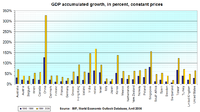
Photo from wikipedia
Background There is no consensus on the management of incidental meningiomas. The literature on long-term growth dynamics is sparse and the natural history of these tumors remains to be illuminated.… Click to show full abstract
Background There is no consensus on the management of incidental meningiomas. The literature on long-term growth dynamics is sparse and the natural history of these tumors remains to be illuminated. Methods We prospectively assessed long-term tumor growth dynamics and survival rates during active monitoring of 62 patients (45 female, mean age 63.9 years) harboring 68 tumors. Clinical and radiological data were obtained every 6 months for 2 years, annually until 5 years, then every second year. Results The natural progression of incidental meningiomas during 12 years of monitoring was growth (P < .001). However, mean growth decelerated at 1.5 years and became insignificant after 8 years. Self-limiting growth patterns were seen in 43 (63.2%) tumors, non-decelerating in 20 (29.4%) and 5 (7.4%) were inconclusive due to ≤ 2 measurements. Decelerating growth persisted once established. Within 5 years, 38 (97.4%) of 39 interventions were initiated. None developed symptoms prior to intervention. Large tumors (P < .001) involving venous sinuses (P = .039) grew most aggressively. Since inclusion 19 (30.6%) patients have died of unrelated causes and 2 (3%) from grade 2 meningiomas. Conclusion Active monitoring seems a safe and appropriate first-line management of incidental meningiomas. Intervention was avoided in > 40% with indolent tumors in this cohort. Treatment was not compromised by tumor growth. Clinical follow-up seems sufficient beyond 5 years if self-limiting growth is established. Steady or accelerating growth warrant monitoring until they reach a stable state or intervention is initiated.
Journal Title: Neuro-oncology practice
Year Published: 2022
Link to full text (if available)
Share on Social Media: Sign Up to like & get
recommendations!